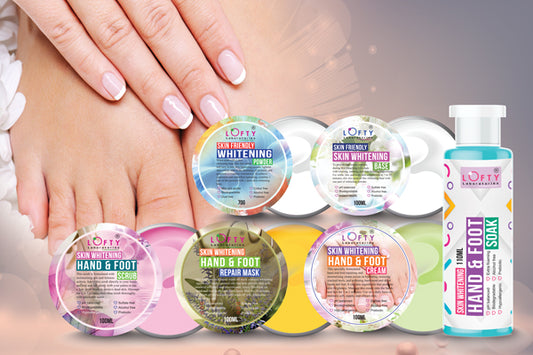
Peel Off to Purify and Glow
Share
Struggling to keep your skin youthful? Discover why peel-off masks might be the game-changer.
What effect do peel-off masks have on your skin, and what ingredients should you look for in a peel-off mask? In this post, we'll answer these common concerns about peel-off masks.
Peel-Off Masks Provide Immediate Results
Peel-off masks are great for treating a variety of skin issues, and they are not as harmful as some might think. These masks can deliver their benefits in less time than it takes to enjoy a quick snack! If you're looking to fix damaged skin, restore your youthful glow, or even just clear your pores, a peel-off mask is one of the best treatments you can use to ensure your skin receives optimal care.
If you want to instantly repair a dull appearance, remove dirt and dead skin cells, and improve blood circulation, a peel-off mask is the perfect treatment for your skin. Peel-off masks work by gently removing the outermost layer of the skin, alleviating dullness and dead skin. This process produces a smoother skin texture and helps balance out pigmentation.

What is a Peel-Off Mask?
Peel-off masks are gel-like products that dry into a film-like consistency before being peeled off in one layer. When removed, dirt, oil, and impurities that clog pores are pulled away, helping to prevent acne-causing bacteria from accumulating. Peel-off masks can also assist in fading fine lines and refining the pores.
The results of a good peel-off mask are often visible right away. Depending on your skin type, the luminous and soothing effects can last for hours. Long-term benefits, such as improved blood circulation and collagen stimulation, may help alleviate rough and uneven skin texture.

Key Ingredients in Peel-Off Masks
Peel-off masks are often made with charcoal, antioxidants, and botanical extracts from fruits and plants. These vital components work together to give your skin a glowing, youthful complexion.
Use an Alcohol-Free Peel-Off Mask
Many peel-off masks use alcohol to speed up drying time, but it's best to avoid those with alcohol. Alcohol can dry out your skin and destroy its natural moisture barrier, leading to irritation and long-term damage.
Peel-Off Masks Illuminate, Smooth, and Soften Your Skin
Peel-off masks gently exfoliate the skin, removing dead skin cells that have accumulated on the surface. This exfoliation process brightens the skin and can give you a more youthful appearance.

Peel-Off Masks Improve Blood Circulation
One major benefit of using a peel-off mask is its ability to increase blood circulation in the skin’s upper layers. The skin-tightening and toning effect stimulates blood flow, which helps deliver nutrients to the dermis and epidermis. This, in turn, promotes collagen production, giving the skin a smooth and even texture—essential for naturally glowing skin.

Peel-Off Masks Absorb Oil Without Overdying the Skin
While a healthy glow is desirable, excessive oil production can lead to a greasy complexion. Peel-off masks help by absorbing excess oil while unclogging and cleansing the pores. Unlike harsh oil-control products, peel-off masks get the job done without causing dryness or dehydration.
Peel-Off Masks Are Suitable for All Skin Types
Another great advantage of peel-off masks is that they are typically suitable for all skin types. If you have dry skin, an alcohol-free peel-off mask can hydrate it quickly. The mask’s sticky texture also helps open clogged pores, making it ideal for oily and combination skin. Some masks contain soothing ingredients that help reduce redness and inflammation, which is beneficial for those with sensitive skin. Always do a patch test before applying a peel-off mask to ensure it doesn't irritate your skin.

Peel-Off Masks Quickly Hydrate Your Skin
Peel-off masks can quickly rehydrate skin, especially if you live in a humid climate or don’t always have time to follow a thorough moisturizing routine. With just a few applications, these masks can bring life back to dry, dehydrated skin.
Peel-Off Masks Remove Peach Fuzz
Peel-off masks can also remove fine facial hair, or "peach fuzz," by adhering to the tiny hairs and gently uprooting them when peeled off. The removal of peach fuzz can improve the overall appearance of your skin, giving it a smoother finish.

How and When to Use Peel-Off Masks
Peel-off masks should generally be used one to two times a week. If you have sensitive skin, stick to once a week, while those with oily skin or clogged pores can use them more frequently. Avoid using masks that contain alcohol, as they can cause dryness and irritation.
An excellent peel-off mask doesn't need to be rinsed after use. Once completely dry, it should peel off in one layer without leaving residue behind. If any residue remains, use a pH-balancing toner to gently remove it. When removing the mask, take your time and avoid pulling too hard to prevent discomfort.
Final Thoughts
Peel-off masks offer multiple benefits, from exfoliating dead skin cells and improving blood circulation to hydrating the skin and removing excess oil. They can be used by all skin types, but it’s important to choose an alcohol-free mask to avoid drying out your skin. With regular use, peel-off masks can help you achieve a brighter, smoother, and more youthful complexion.
References
- Bae, J. H., & Kim, H. K. (2020). “Effectiveness of Charcoal Peel-Off Masks in Skin Care: A Review.” Journal of Cosmetic Dermatology, 19(4), 853-860.
- Kottner, J., Lichterfeld, A., & Blume-Peytavi, U. (2013). “Dirt, Oil, and Dead Skin Removal Through Peel-Off Masks.” Dermatology Research and Practice, 2013.
- Fischer, T. W., & Wigger-Alberti, W. (2019). “Peel-Off Mask Benefits for Hydration and Exfoliation.” Journal of Dermatological Treatment, 30(7), 704-711.











